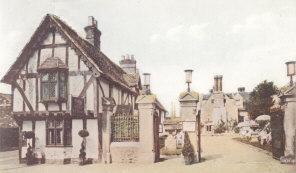
Thame Almshouses
Richard Quartremain, a wealthy merchant of North Weston in the parish of Thame, and his wife Sibyl, founded the chantry or guild of St Christopher in 1447.
This included an almshouse or 'hospital' for six "poor men".
Rent for the almshouse was provided from a farm in Long Crendon and certain 'divers tenements' in Thame.
Payments included 6d. a week to each of the five poor men, and one woman, with an additional 1d. a week for bread for each, and, a sum of 5s. a year for their smocks and 22s 1d. on the repair of the almshouses.
In 1548, during the Reformation, the chantry was dissolved, and by 1550 ownership had passed to Sir John Williams.
It is believed that the current building (now used as private dwellings) was built shortly after this date, replacing the original 'hospital' building which stood close by, next to the church.
(It has been suggested that this was on the site of the Grammar School.)
Lord Williams, in his will of 1559... "I will certaine landes and tenements in Sidnam [Sydenham] late p(ar)cell of littell more to my executors for ever for the intente with to augmente and increase the Almes howses of Tame and the livinge of the poore in the same"...
In 1575 the income included the rents from the original foundation, the augmentation from Lord Williams' will, and also from land in East Hendred, Berkshire, and three tenements in Thame. The total endowment at this time amounted to around £45 a year.
The property was vested with the Warden of New College, Oxford in 1575 (together with the Grammar School), and the headmaster of the school acted as secretary and housekeeper to the almshouses.
The almsmen and almswoman were provided with a black 'frize' gown each year, at 'Allhollentide' (Oct 31st), and at Christmas every fourth year, a red 'frize' gown for Sunday best, complete with silver badge worn on the left arm bearing the arms of Lord Williams.
The five men and one woman were chosen by Lord Norreys or his heirs (later the Earls of Abingdon). Unless prevented by infirmity, they were expected to attend the parish church for morning and evening service daily, and on Sundays and festivals to sit in the chancels around Lord Williams' tomb.
The oldest almsman was paid an extra 4s. a year for cleaning the watercourse between the almshouse and the privy at the corner of the school orchard. The almswoman was expected to nurse the infirm.
By the mid seventeenth century, the weekly payment to each recipient had risen to 2s. 5d.
In the early 19th century, the almshouses had developed a reputation for drunkenness and immorality (in flagrant abuse of the statutes), allegedly encouraged by the occupants of the houses on the other side of Church Row.
This had apparently improved by 1860, but at which time the condition of the almshouse was stated to be very poor.
With the demise of the school in the early 1870's, the almshouses were sold by the Endowed School Commission, and the income used to provide a yearly allowance of £33 6s. 8d. to each of the almspeople, in lieu of the former allowances and residence.
The almshouse building, is of 2 storey, timber frame construction, with oversailing jettied first floor. It was originally divided into six cottages, each with two rooms.
After its sale, the building has been used as store rooms, tea rooms, and now as private dwellings.
What are almshouses?
Lord Williams of Thame
Thame Grammar School